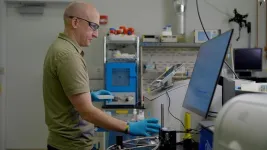(Press-News.org) In a significant finding, researchers from The Jackson Laboratory (JAX) and UConn Health have discovered that sodium valerate, a short-chain fatty acid produced by gut microbes, can dramatically reduce binge drinking behavior and blood ethanol concentration in mice. The study, reported June 17 in Microbiome, offers promising insights into the gut-brain axis and presents a novel therapeutic approach for excessive alcohol use.
We are interested in physiological addiction genetics and genomics to identify new drug targets for treating addiction/overdose.
The research team, led by Yanjiao Zhou, M.D., Ph.D., associate professor of medicine at UConn Health, and Jason Bubier, Ph.D., senior research scientist at JAX, conducted a detailed investigation into the effects of short-chain fatty acid (SCFA) supplementation on alcohol consumption patterns in a mouse model. They administered three individual SCFAs and found that sodium valerate led to a 40% reduction in alcohol intake and a 53% decrease in blood ethanol levels. These results were accompanied by significant molecular changes that suggest sodium valerate could be a potent new therapy for reducing binge drinking.
Despite the widespread prevalence of alcohol use disorder, only three medications to date—disulfiram, naltrexone, and acamprosate—have been approved by FDA for treating patients. Most recently, the FDA approved naltrexone as an oral medication in 1994 and as an extended-release injectable in 2006.
“The study expands our understanding of the important relationship between the gut microbiome and alcohol consumption,” said Bubier. “There is strong evidence that binge drinking significantly alters the microbiome in ways that accelerate the cycle of addiction via the gut-brain axis. Our findings provide a possible biological explanation for why that occurs and identify a potential therapy for reducing excessive alcohol use.”
Zhou, Bubier and colleagues, including Suresh Bokoliya, a postdoc in the Zhou lab, conducted further analyses comparing mice administered sodium valerate with those given sodium chloride, commonly known as table salt, as a control. The data revealed that sodium valerate not only reduced binge drinking but also diminished anxiety-like or approach-avoidance behaviors compared to the control group. Furthermore, elevated levels of gamma-aminobutyric acid (GABA), a neurotransmitter implicated in neuropsychiatric and alcohol use disorders, were detected in the brain, stool, and blood of the mice following sodium valerate supplementation.
Another key aspect of the study involved assessing the impact of sodium valerate on brain function. Through RNA sequencing of the amygdala, a brain region associated with emotional regulation, the team identified significant changes in gene expression related to neuroinflammation, neurotransmission, mitochondrial regulation, and G protein-coupled receptor signaling. These findings suggest that sodium valerate influences multiple signaling pathways in the brain, which may mediate its effects on alcohol consumption.
"The implications of our study are significant," said Zhou. "By demonstrating how sodium valerate alters gene expression and neurotransmitter levels, we provide a multifaceted explanation for its potential as a treatment for excessive alcohol consumption."
This research underscores the critical role of the gut microbiome in addiction and highlights the therapeutic potential of targeting the gut-brain axis. Sodium valerate supplementation, with its ability to reduce binge drinking and anxiety-like behaviors, offers a promising new avenue for treating alcohol use disorders.
END
Study reveals potential therapeutic role of sodium valerate in reducing binge drinking
Researchers uncover gut-brain connection that may mediate alcohol consumption in mouse model
2024-06-25
ELSE PRESS RELEASES FROM THIS DATE:
Your future medications could be personalized for you on a 3D printer
2024-06-25
Chocolate-flavored pills for children who hate taking medicine.
Several drugs combined into one daily pill for seniors who have trouble remembering to take their medications.
Drugs printed at your local pharmacy at personalized dosages that best suit your health needs.
These are just a few potential advantages of 3D drug printing, a new system for manufacturing drugs and treatments on-site at pharmacies, health care facilities and other remote locations.
In 2015, the Food and Drug Administration approved the first 3D-printed drug, Spritam ...
Study finds foreign-born CEOs likelier to acquire international targets, including in their birth country
2024-06-25
Toronto - New research shows that CEOs who have moved away from their country of origin have a significantly higher tendency to make acquisitions internationally, with a preference for targets in their birth country or in countries that once colonized it.
“Foreign-born CEOs are taking an increasing leadership role in the corporate world,” says researcher Ron Shalev, an associate professor of accounting at the University of Toronto Scarborough who is cross-appointed to U of T’s Rotman School of Management. “In our sample, 24 per ...
For better loan terms, find a partner
2024-06-25
Shoppers browsing through blouses and blenders at Target know they can also quaff a cappuccino at one of more than 1,700 Starbucks cafeshoused within Targets. The strategic alliance benefits both corporations by helping them reach new markets, boost their brands, and add incremental sales.
Collaborative partnerships such as this have grown at a pace of 3,600 per year, according to the SDC Platinum database. That’s partly because companies in alliances can gain access to new technologies and customers while keeping their autonomy.
New research from Texas McCombs highlights ...
How uncertainty builds anxiety
2024-06-25
Alfred Hitchcock observed that “There is no terror in the bang, only in the anticipation of it.” A common way to build suspense in a movie scene is for the audience to know something bad is going to happen, but not when it is going to happen. But how does uncertainty work to ratchet up our anxiety? In a recent paper in the journal Computational Psychiatry, researchers at the University of California, Davis, Department of Psychology take a deeper look into what builds fear.
Not knowing when something will happen can cause anxiety, but until ...
Adolescents today are more satisfied with being single
2024-06-25
Young people aged 14 to 20 years are nowadays more satisfied with being single than their counterparts ten years ago. This is the conclusion of a study undertaken by the Institute of Psychology at Johannes Gutenberg University Mainz (JGU). "It seems that today's adolescents are less inclined to pursue a romantic relationship. This could well be the reason for the increased singlehood satisfaction," said psychologist Dr. Tita Gonzalez Avilés, lead author of the recent study. Growing numbers of people are living as ...
Researchers discover new flat electronic bands, paving way for advanced quantum materials
2024-06-25
In a study published in Nature Communications June 19, a team of scientists led by Rice University’s Qimiao Si predicts the existence of flat electronic bands at the Fermi level, a finding that could enable new forms of quantum computing and electronic devices.
Quantum materials are governed by the rules of quantum mechanics, where electrons occupy unique energy states. These states form a ladder with the highest rung called the Fermi energy.
Electrons, being charged, repel each other and move in correlated ways. ...
Discovery of vast sex differences in cellular activity has major implications for disease treatment
2024-06-25
By Darrin S. Joy
“We discovered a pronounced ‘men are from Mars, women are from Venus’ pattern,” says marine and environmental biologist Suzanne Edmands.
She refers not to human psychology, but rather to mitochondria, the cell components responsible for generating energy.
Edmands, professor of biological sciences at the USC Dornsife College of Letter, Arts and Sciences, recently published research in the Proceedings of the National Academy of Sciences that reveals vast differences in gene activity within the mitochondria of males compared to females.
Although the study looks at tiny marine organisms called copepods, ...
nTIDE June 2024 Deeper Dive: Employment trends for people with disabilities highlight continued gains for those with vision impairments
2024-06-25
East Hanover, NJ – June 25, 2024 – The employment-to-population ratio for individuals with vision impairments continues to show marked improvement, according to data shared during the according to last Friday’s National Trends in Disability Employment (nTIDE) Deeper Dive Lunch & Learn Webinar. nTIDE is a joint effort by Kessler Foundation and the University of New Hampshire’s Institute on Disability (UNH-IOD).
Director of Research Arielle Silverman, PhD, and Research Specialist Sarahelizabeth Baghun, PhD, from the ...
WVU refining at-home sleep apnea detection device to help with more efficient diagnosis, treatment
2024-06-25
West Virginia University researchers will put a sleep apnea detection device at the fingertips or wrists of patients facilitating early diagnosis and treatment of the disease with support from a National Science Foundation grant.
Dr. Sunil Sharma, N. Leroy Lapp Professor and division chief of the Pulmonary, Critical Care and Sleep Medicine Fellowship Program in the WVU School of Medicine, received the award after working with other WVU researchers to develop prototypes and secure a patent.
“It’s about taking technology from the lab to the bedside,” Sharma said. ...
UC San Diego receives $5 million to support geriatrics workforce enhancement program
2024-06-25
The University of California San Diego has been selected for the third time to participate in the Geriatrics Workforce Enhancement Program (GWEP). This highly selective program comes with a $5 million grant from the Health Resources and Services Administration (HRSA). These funds will be used over the next five years to support the San Diego Imperial Geriatric Education Center (SDIGEC), which provides geriatric educational programming to health workers and other care providers across both San Diego and ...
LAST 30 PRESS RELEASES:
Ants: An untapped resource in the development of antibiotics?
Archaeologists use AI to create prehistoric video game
Mitochondria migrate toward the cell membrane in response to high glucose levels
Tiny viral switch offers hope against drug-resistant bacteria
Most parents aware of early peanut introduction guidelines, but confused about details
HPV vaccine can protect against severe lesions of the vulva and vagina
Virtual care provision and emergency department use among children and youth
Quadrivalent HPV vaccine and high-grade vulvovaginal lesions
Insights into dry eyes gained from stem cell-derived tear glands
Researchers identify 166 human pluripotent stem cell lines available for use in clinical applications
Europa Clipper instrument uniquely observed interstellar comet 3I/ATLAS
UN University Report challenges climate change as sole trigger of Syrian Civil War, exposing governance failures in drought response
Real estate investment trust (REIT) acquisition associated with hospital closure and bankruptcy
New Raman imaging system detects subtle tumor signals
Boston Children’s receives a $7.5 million grant from Aligning Research to Impact Autism (ARIA) to provide clinical research coordination for the IMPACT Network
Spray-on antibacterial coating offers new protection for plants against disease and drought
ESMT Berlin study: What makes a first offer successful in negotiations
Groundbreaking ceremony marks the beginning of CTAO-South Array construction in Chile
Why swearing makes you stronger
What prevents more cancer patients from enrolling in potentially life-saving clinical trials?
UK’s worst-case climate risks laid bare for lawmakers
A decline in churchgoing linked to more deaths of despair
TAMEST announces Maralice Conacci-Sorrell, Ph.D., UT Southwestern Medical Center, as 2026 Mary Beth Maddox Award & Lectureship Recipient
Global study to evaluate whether dengue outbreaks can be anticipated earlier
Chonnam National University researchers propose innovative voltage-loop control for power factor correction
Accelerating next-generation drug discovery with click-based construction of PROTACs
Detecting the hidden magnetism of altermagnets
$7M gift supports health research, engineering and athletics at UT San Antonio
NU-9 halts Alzheimer’s disease in animal model before symptoms begin
Hospitals acquired by real estate investment trusts associated with greater risk of bankruptcy, closure
[Press-News.org] Study reveals potential therapeutic role of sodium valerate in reducing binge drinkingResearchers uncover gut-brain connection that may mediate alcohol consumption in mouse model



